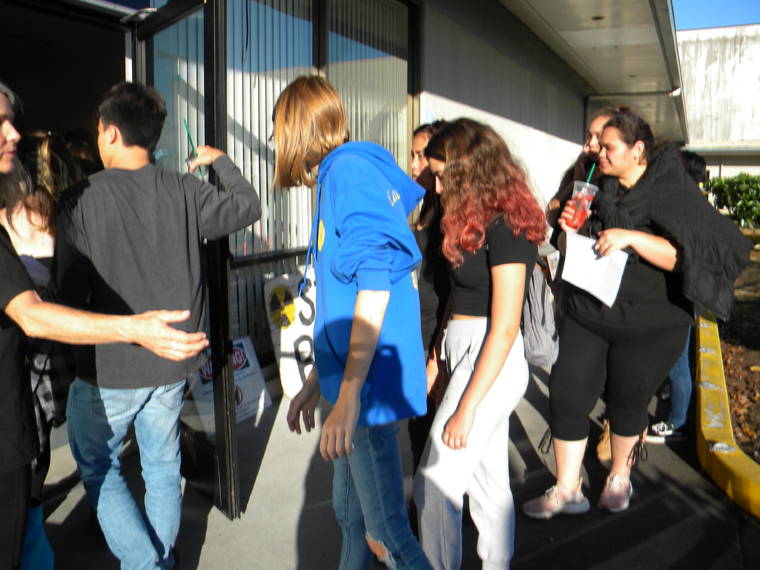Video shows PTA public meeting
Protecting Native Hawaiian archaeology from Pohakuloa Training Area bombing exercises was top of mind for those attending a May 16 annual meeting with PTA officials, according to video footage provided by a participant.
The raw footage, broken into 41 segments of varying lengths and provided by Lindafaye Kroll, a registered nurse who heads a nonprofit protesting bombing at PTA, shows a glimpse of a meeting dominated by cultural and environmental concerns.
ADVERTISING
West Hawaii Today used the footage because a reporter was denied access to the meeting, which was otherwise open to the public. Lt. Col. Loreto V. Borce Jr., commander of U.S. Army Garrison Pohakuloa, and Greg Fleming, deputy commander, on Monday called the reporter to apologize, saying they were unaware two Army staffers told the reporter she couldn’t stay.
The meeting was originally billed as invitation-only with consulting parties who’d signed on to an agreement governed by the National Historic Preservation Act. It was subsequently opened to the public.
“Many of you are part of the consulting parties,” Fleming said at the beginning of the meeting, according to the video. “But there’s others that are not and that’s OK to come in.”
The purpose of the meeting was to gather input on an abbreviated annual report that covers just the first few months, from Sept. 27 to Dec. 31, the first of a four-year annual process. During the two-hour meeting, the Army fielded questions about historical and archaeological surveys, bombing activities and depleted uranium contamination from 1960s spotter rounds.
Native Hawaiians described their culture and the significance of the land on the mountain.
Leilani Lindsey-Kaapuni said she and a group conducted a makahiki ceremony at PTA in January.
“We dedicated that area to restoration and to peace and we felt that it was important to hold that ceremony and we would hopefully like to hold that ceremony in the future and to include more of our people. Pohakuloa is sacred to us,” she said. “When our kupuna said an area was kapu, it was not just a superstition. It meant that that land and the resources there were absolutely necessary to sustain life on this island.”
Lindsey-Kaapuni said there are large aquifers under Pohakuloa that she fears are being contaminated by depleted uranium.
People at the meeting also were concerned about how much of the 134,000-acre military training area is being surveyed and why no survey results had been reported.
“Less than one-third of Pohakuloa Training Area has been surveyed,” said Jim Albertini. “Pohakuloa has been bombed for 75 years, yet only one-third of the area has been surveyed for cultural and religious sites.”
That boils down to money, Fleming said.
“From an environmental standpoint, we are underfunded for our requirements,” Fleming said. “Last year we only got funded 47% of our requirements.”
Cory Harden questioned the background and training of the archaeologists and surveyors.
“Hawaiian archaeology can be very subtle and very difficult to find the archaeological features unless you have some good background in Hawaiian archaeology,” Harden said.
Julie Taomia, Pohakuloa cultural resource manager, said many of the surveyors have training from the University of Hawaii and have specifically studied Native Hawaiian and Pacific Island archaeology.
“For archaeological sites, we’re looking for physical remains of human activity. We’re looking for artifacts .. features that have been built. Especially once you get used to looking for it, that is fairly obvious,” Taomia said. “Traditional cultural properties are another matter. They are identified by the people to whom they are important places. And in the studies that have been done, people have been interviewed and we have sought the information and it just has not … no properties of this type have been identified to date.”
PTA also works with an advisory committee, of whom almost half are of Hawaiian ancestry, said Borce, who is also of Hawaiian ancestry.
“They have that background from their family back and they understand what’s going on in the Hawaiian culture,” Borce said.
The annual report listed 20 “items of concern” involving unexploded ordnance at PTA.
Two were deemed safe to remove and were detonated at Range 9, while others had to be blown in place, the report said.
The two-page report further states that no disputes or objections regarding the implementation of the programmatic agreement were received during the reporting period, no inadvertent or post-review discoveries were made and two training sessions were held for range staff.
Email Nancy Cook Lauer at ncook-lauer@westhawaiitoday.com.


